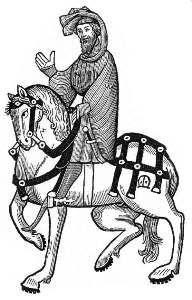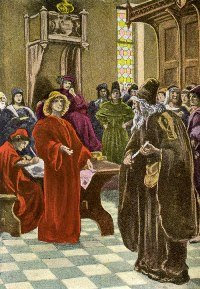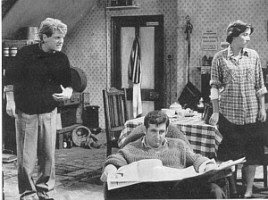The tweed jacket of Jimmy Porter in Look back in Anger, the coral trinket of the Nun in the Canterbury Tales, the funny fashion sense of Falconbridge in The Merchant of Venice… literature has been playing a background for booming trend of fashion.
Clothes, accessories, jewellery, cosmetics and footwear symbolise the realities of emotion, economy and society.
It is not important what we wear rather why we wear. Through three of my favourite literary works from our syllabus, I have tried to portray the fashion through the prism of periods. I endeavour to draw a connection and a parallel between the two creative arts. 
Canterbury Tales by Geoffrey Chaucer
Period: Middle Age
Fashion trends: Chaucer gives us many evocative descriptions of the English costumes of his days through Canterbury Tales. New and more eccentric versions of the garments were adopted, each attracting howl of protest from the clergy, historians and even the courts. Fashion in this age, saw a change in attitude and in emphasis.
Several factors worked in pushing high fashion in the Middle Age: increased exports from the East in the wake of The Crusades, increased production and improved quality of textiles in the West, the wealth of a rising urban tradesman class.
The Knight’s dress has been described as ‘stained coarse cotton tunic’. The Squire’s youthful vanity is symbolised by the excessive floral brocade on his tunic.
The Physician loves rich silk and fur-trimming of his gown. Brighter colors, better materials and a longer jacket length were usually synonymous to immense wealth. The clothing of the aristocracy and wealthy merchants tended to be elaborate. Towards the end of the Middle Age, men belonging to wealthy classes sported hose and a jacket, often with pleating or skirting, or a tunic with a surcoat.
The Nun wore a coral trinket on her arm. While the standard habit of a nun is subdued and simple, the added touch of the coral trinket emanates her femininity. She wore her gaudy beads on a shiny gold brooch. Most jewels produced during this time were either for the Court or the Church. Most of the holy orders wore long woolen habits in emulation of Roman clothing. St Benedict stated that a monk’s clothes should be plain and comfortable. They were allowed to wear linen coifs to keep their heads warm.
The Wife of Bath’s clothes veer a bit toward extravagance: her face is wreathed in heavy cloth, the colour of her stockings is fine scarlet, and the leather on her shoes is soft and fresh. Women wore flowing gowns and elaborate headwear in shapes of hearts or butterflies. Tall steeple caps and Italian turbans also adorned their heads.
The Merchant of Venice by William Shakespeare
Period: Elizabethan Age
Fashion trends: Fashion in this period covers the transition from the softly constructed linear fashions of the late gothic and early Italian Renaissance styles to the far more rigidly constructed, padded and rather more blocky looking Tudor or Northern European Renaissance style. Literature giants like Shakespeare, Spenser and Marlowe found their inspiration in foreign classics.
Shakespeare, perhaps, is the most prominent of litterateurs to use innovative yet stylish costumes in his plays. Some of the most prominent characters of his plays – Beatrice in ‘Much Ado About Nothing’, Audrey in ‘As You Like It’, Julia in ‘The Two Gentlemen of Verona’ and Portia in ‘The Merchant of Venice’ among others – have acted as fashion icons of their times.
In the Merchant of Venice, Portia says of Falconbridge, the young baron from England: “How oddly he is suited! I think he bought his doublet in Italy, his round hose in France, his bonnet in Germany, and his behavior elsewhere.” (I.ii.68-70)
he bought his doublet in Italy, his round hose in France, his bonnet in Germany, and his behavior elsewhere.” (I.ii.68-70)
Both literature and fashion in sixteenth-century England were influenced by the socio-cultural activities in the other parts of the world. The names of parts of the Elizabethan wardrobe in Shakespearean plays indicate their foreign origins – French hose, French hood, Venetians, Spanish bonnet.
Typical male character is marked by French design. He wears a peasecod doublet, venetians, hose, shoes without heels, and a band (ruff). The sleeves (usually detachable and interchangeable with other outfits) and the venetians are brocade. His hose are silk, since during Elizabeth’s reign, the English learned the secret of hand weaving silk hose and they became the rage before the end of the 16th century.
A typical female would wear her hair tightly curled or frizzed over pads, arcelets, a popular style in England at the time. The square neckline is typical. The shoulder roll is added to the upper sleeve. The girdle pendant includes a pomander. Her skirt rests on a bum-roll farthingale. The sleeves and bodice are of brocades, while the underskirt matches the band around the skirt.
Look Back in Anger by John Osborne
Period: Post Modern (1950s)
 Fashion trends: In post war Britain, utility clothes, ration books and identity cards became the way of life. In 1950’s saw the country trying hard to get out of the World War shadow.
Fashion trends: In post war Britain, utility clothes, ration books and identity cards became the way of life. In 1950’s saw the country trying hard to get out of the World War shadow.
Osborne’s Look Back in Anger gives us a preview of that time both in terms of society and fashion. He has intelligently used the imaginary of clothing to reflect the divide, the tension and the chaos of the society.
Neckties, an important invention of modern times find its place among ‘books, odds and ends’. The small wardrobe above the gas stove signifies either two things – lesser interest in clothes or less money to buy clothes. In the play, latter seems to be the case.
Jimmy, the angry young man wears a ‘worn tweed jacket and flannel’ which reflects his stature in the society. His dressing style reflects that of the striving lower middle class caught in the web of the welfare state. On the other hand we have Cliff who is wearing ‘a pullover and grey, new but very creased trousers’.
Later years in the decade saw a revival of the British spirit. Mass production, the introduction of synthetic fabrics and the comparative prosperity of the late fifties enabled the average British woman to be one of the best dressed women in the world.
Osborne has interestingly dressed Alison, the wife and Helena, the mistress in total contrast. Alison with her high class fashion sense reflects the ‘lady-like figure’ of the mid-fifties. While, ‘Sweater Girl’, a reflection of Helena’s ‘expensively dressed’ yet outward, too-visible and vulgar attitude rivals this notion.
Men’s costume broke free from the restriction of the war. Teddy Boys, a new style noted for their slicked back, long hair, waist coats and sharp shoes evolved.
Literature and fashion are the two important parameters of culture. Both, over the ages, have reflected in each other. My focus, while correlating these arts, has been more on the socio-political issues than psychological.